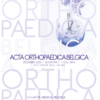A prospective study of 93 unicompartmental knee prosthesis emphasises the appearance of radiolucencies under the tibial component
Total knee arthroplasty; partial knee prosthesis; revision prosthetic surgery
Published online: Feb 17 2023
Abstract
Background and study aims: Here, we report the presence of radiolucent lines in a consecutive group of 93 partial knee replacements (UKA).
Materials and methods: The prospective study was conducted from 2011 to 2019 with a minimum follow-up of two years. Clinical data and radiographs were recorded. Of the 93 UKA, 65 were cemented. The Oxford Knee Score was recorded before and two years after surgery. In 75 cases, the follow-up was conducted at > 2 years. A lateral knee replacement was performed in 12 cases. In one case, a medial UKA with patellofemoral prosthesis was performed.
Results: In eight patients (8.6%), a radiolucent line (RLL) underneath the tibia component was observed. In four of these eight patients, RLLs were non-progressive, without clinical implications. In two cemented UKAs, RLLs were progressive and were revised with total knee arthroplasty. Early severe osteopenia of the tibia (zone 1 to 7) in the frontal view was observed in two cementless medial UKA cases. The demineralisation occurred spontaneously five months after surgery. We diagnosed two early deep infections, one of which was treated locally.
Conclusions: RLLs were present in 8.6% of the patients. Even in severe cases of osteopenia, spontaneous recovery of RLLs is possible with cementless UKAs.
